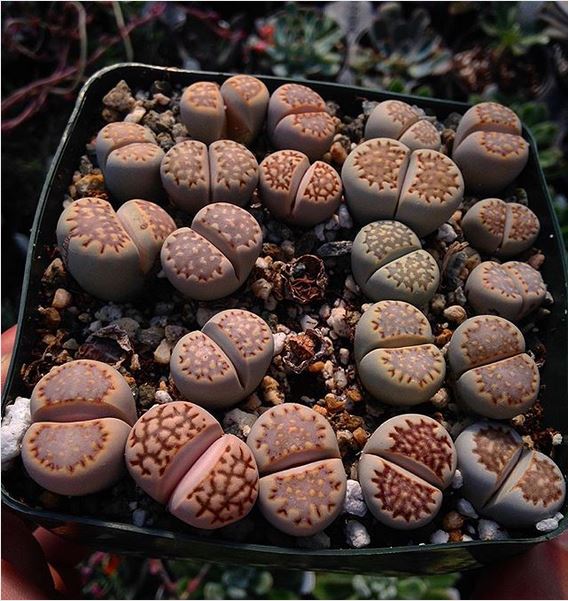I will never forget the first time I laid eyes on a Lithops. These odd little succulents are truly marvels of evolution. The so-called "living stones" really do earn their name as most are exquisitely camouflaged to match the gravelly soils in which they grow. If bizarre color patterns weren't enough, Lithops, as well as many other succulents, live their lives almost completely buried under the soil. All one ever really sees is the very tip of their succulent leaves and the occasional flower.
It is the tips of those leaves that make people swoon. Lithops belong to a hodgepodge mix of succulent genera and families that produce windowed leaves. Aside from their striking patterns, the tips of their leaves are made up of layers of translucent cells, which allow light to penetrate into the interior of the leaf where the actual photosynthetic machinery is housed. Their semi-translucent leaves, coupled with their nearly subterranean habit, have led to the assumption that the leaf windows allow the plants to continue photosynthesis all the while being mostly buried. Despite the popularity of this assumption, few tests had been performed to see whether or not the windows function as we think. All of that changed back in the year 2000.
As hinted at above, a variety of succulent plants have converged on a similar leaf morphology. This is where things get a bit strange. Not all plants that exhibit the leaf window trait find themselves buried in the soil. Others, such as Peperomia graveolens for example, produce the photosynthetic tissues on tall stems. Examples like this led at least some researchers to second guess the common assumption of windows increasing photosynthesis and the resulting investigations were surprising to say the least.
Peperomia graveolens. © Raimond Spekking / CC BY-SA 4.0 (via Wikimedia Commons)
A duo of researchers decided to test the assumption that leaf windows increase photosynthesis by channeling light directly to the photosynthetic machinery inside. The researchers used tape to cover the leaf windows of a variety of succulent plant species. When they compared photosynthetic rates between the two groups, not a single difference was detected. Plants who had their leaves covered photosynthesized the same amount as plants with uncovered leaves. These data were quite shocking. Because they tested this assumption across a variety of plant species, the results suggested that the function of windowed leaves isn't as straight forward as we thought. These findings raised more questions than they solved.
Subsequent experiments only served to reinforce the original findings. What's more, some even showed that plants with covered windows actually photosynthesized more than plants with uncovered windows. It seems that windowed leaves function in a completely opposite manner than the popular assumption. The key to this patterns may lie in heat exchange. When the researchers took the temperature of the interior of the leaves in each group, they found that internal leaf temperatures were significantly higher in the uncovered group and this has important implications for photosynthesis for these species.
High leaf temperatures can be extremely damaging to photosynthetic proteins. If too much light filters through, leaf temperatures can actually hit damaging levels. This is one reason that many of these plant species have adopted this bizarre semi-subterranean habit. Plants that experienced such high temperatures throughout the course of a day had permanent damage done to their photosystems. This led to a reduction of fitness over time. Such lethal temperature spikes did not happen to leaves that had been covered.
Haworthia truncata. Photo by www.haworthia-gasteria.com
If you're anything like me, at this point you must be questioning the role of the leaf windows entirely. Why would they be there if they may actually hurt the plants in the long run? Well, this is where knowing something about the habitat of each species comes into play. Not all leaf windows are created equal. The patterns of their windows vary quite a bit depending on where the plants evolved. In 2012, a paper was published that looked at the patterns of Lithops leaf windows in relation to their place of origin. Not all Lithops grow in the same conditions and various species hail from regions with vastly different climates.
What the paper was able to demonstrate was that Lithops native to regions that experience more average annual rainfall have much larger window areas on their leaves than Lithops native to drier regions. Again, the underpinnings of this discovery nonetheless have to do with light availability. Wetter areas experience more cloud cover than drier areas so Lithops growing where its cloudy have to cope with a lot less sun than their more xeric-growing cousins. As such, having a larger window allows more diffuse light into the leaf for photosynthesis without having to worry about the damaging temperatures.
Photo by Petra licensed under CC BY-NC 2.0
The reverse is true for Lithops from drier climates. They have smaller leaf windows because they experience more days with direct sun. Smaller windows means less sunlight entering the leaf. This serves to keep internal leaf temperatures within a much safer range, thus protecting the delicate proteins inside. As it turns out, leaf windows seem to represent a trade-off between photosynthesis and overheating. What's more, some window-leaved species seem to be evolving away from the light transmitting function of their cousins living in shadier conditions. If anything, this serves as a reminder that simply because something seems obvious, that doesn't mean its always true. Stay curious, my friends!





